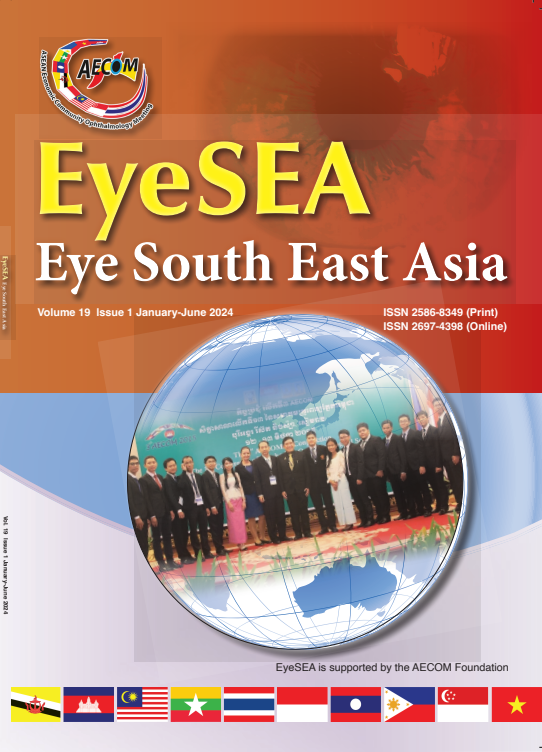A Comparative Study of Pain Intensity in Patients Receiving Cooling Botulinum Toxin (BTX) and Non-cooling BTX
Main Article Content
บทคัดย่อ
Objective: To compare pain intensity in the patients who receive both cooling Botulinum toxin (BTX) injections and non-cooling BTX injections around the periocular area.
Methods: A Prospective, randomized, single-blind controlled trial study of patients who had bilateral blepharospasm or bilateral hemifacial spasm between June 2021 and October 2022. Each patient received 10 points of BTX injections around the periocular area (randomized into 5 injection points each of cooling and non-cooling BTX respectively). A visual analog scale (VAS) was used to measure the pain intensity immediately after injection at each point. Main outcome measures: pain score and complication. cooling botox: 15-18℃, non-cooling botox: room temperature 25-27℃.
Results: A cohort of 11 patients received 55 points for cooling BTX injections and 55 points for non-cooling BTX injections. The mean pain score of the cooling BTX group was 1.91 ± 1.59, while the non- cooling BTX group had a mean pain score of 1.89 ± 1.59, the difference was not statistically significant (p = 0.887). The highest pain levels in both groups were at the upper eyelids and lower (mean pain score of 2.0).
Conclusion: There was no significant difference in the pain intensity and complication between cooling BTX and non-cooling BTX injections.
Conflicts of Interest: none
Article Details

อนุญาตภายใต้เงื่อนไข Creative Commons Attribution-NonCommercial-NoDerivatives 4.0 International License.
เอกสารอ้างอิง
Hallett M. Blepharospasm: Recent advances. Neurology. 2002;59:1306-1312.
Wang A, Jankovic J. Hemifacial spasm: Clinical findings and treatment. Muscle and Nerve. 1998;21:1740-1747.
Osako M, Keltner JL. Botulinum A toxin (Oculinum) in ophthalmology. Surv Ophthalmol. 1991;36:28-46.
Scott A, Kenny EG, Stubbs HA. Botulinum toxin injection as a treatment for blepharospasm. Arch Ophthalmol. 1985;103:347-50.
Gonnering RS. Pharmacology of botulinum toxin. International Ophthalmology Clinics. 1993;33:203-226.
Soylev MF, Kocak N, Kuvaki B, Ozkan SB, Kir E. Anesthesia with EMLA cream for botulinum A toxin injection into eyelids. Ophthalmologica. 2002;216:355-358.
Linder JS, Edmonson BC, Laquis SJ, Drewry RD Jr, Fleming JC. Skin cooling before periocular botulinum toxin injection. Ophthalmic Plastic & Reconstructive Surgery. 2002;18:441-442.
Sarifakioglu N, Sarifakioglu E. Evaluating the effects of ice application on the pain felt during Botulinum toxin type-A injections: A prospective, randomized, single blind controlled trial. Annals of Plastic Surgery. 2004;53:543-546.
Eppley BL. Easing Botox administration with EMLA cream. Aesthetic Surgery Journal. 2004;24:79-81.
Elibol O, Ozkan B, Hekimhan PK, Caglar Y. Efficacy of Skin Cooling and EMLA Cream Application for Pain Relief of Periocular Botulinum Toxin Injection. Ophthalmic Plastic and Reconstructive Surgery. 2007;23:130-133.
Saeki Y. Effect of local application of cold or heat for relief of pricking pain. Nursing and Health Sciences. 2002;4:97-105.
Dutton JJ. Botulinum A toxin in the treatment of craniocervical muscle spasms: Short and long-term, local and systemic effects. Survey Ophthalmol. 1996;41:51-65.
Sarrabayrouse MAM. Indications and limitations for the use of Botulinum toxin for the treatment of facial wrinkles. Aesthetic Plastic Surgery. 2002;26:233-8.
Mandeville JTH, Rubin PAD. Injectable agents for facial rejuvenation: Botulinum toxin and dermal filling agents. International Ophthalmology Clinics. 2004;44:189-212.
Khan JA. Cosmetic Botulinum neurotoxin application. International Ophthalmology Clinics. 2005;45:107-122.
Grandas F, Elston J, Quinn N, Marsden CD. Blepharospasm: A review of 264 patients. Journal of Neurology Neurosurgery & Psychiatry. 1988;51:767-772.
Lander J, Hodgins M, Nazarali S, Mctavish J, Ovellette J, Friesen E. Determinants of success and failure of EMLA. Pain. 1996:64;89-97.


